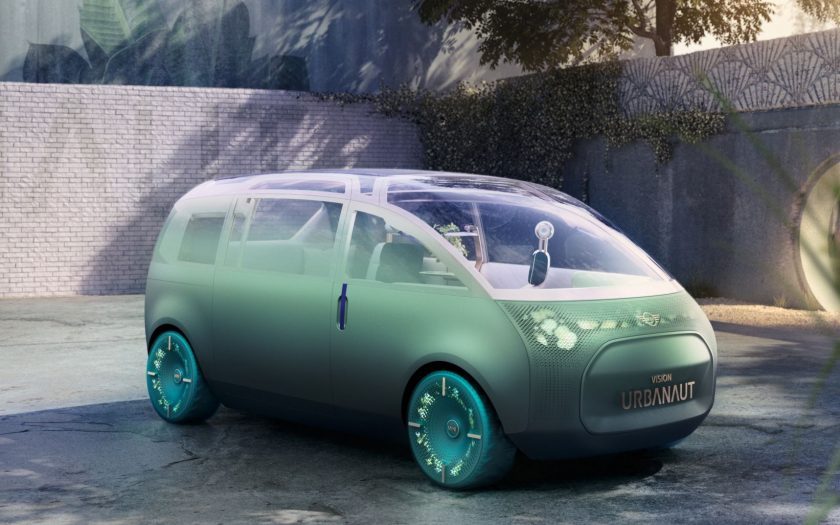CAR DESIGN IS ADVANCING in leaps and bounds, even if many of the ideas being floated will probably never see the light of day in full production. But they do indicate where motor vehicle transport is headed.
The Mini brand is using #NEXTGen 2020 to present, in a world exclusive, the Mini Vision Urbanaut – an all-new interpretation of a personal space in a car.
This digital vision vehicle offers more interior space and versatility than ever before, on a minimal (their pun, not ours) environmental footprint.
“The Mini brand has always stood for ‘Clever Use of Space’. In the Mini Vision Urbanaut, we extend private space far into the public realm, creating completely new and enriching experiences,” explains Adrian van Hooydonk, Head of BMW Group Design.
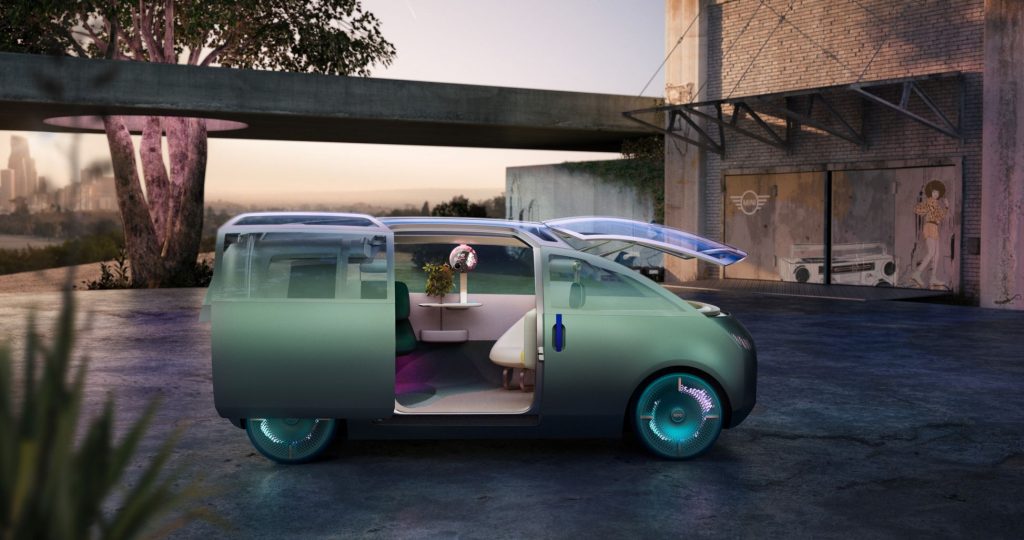
Mini moments.
“Mini sees its future self primarily as an enabler of and companion for unforgettable times – what we might call ‘Mini moments’. The Mini Vision Urbanaut uses three curated Mini moments – “Chill”, “Wanderlust” and “Vibe” – to present a wide range of possible usage scenarios. The Chill moment invites you to catch a breath and pause in the here and now. The car becomes a retreat, a haven where you can relax – or work with full concentration – during a journey. Wanderlust is the only Mini moment where the Mini Vision Urbanaut is being driven or driving with automated driving functions. Finally, the Vibe moment puts social time with other people at centre stage”, adds Oliver Heilmer, Head of Mini Design.
The exterior and interior change to reflect the Mini moment at hand and give the experience the best possible stage. An all-encompassing user experience design, sustainable materials and a purely electric drive system are additional ingredients of the overall concept.
Um, we’re not sure what that all means, but it certainly sounds impressive. If you have an idea, we’d appreciate you enlightening us here at seniordriveraus
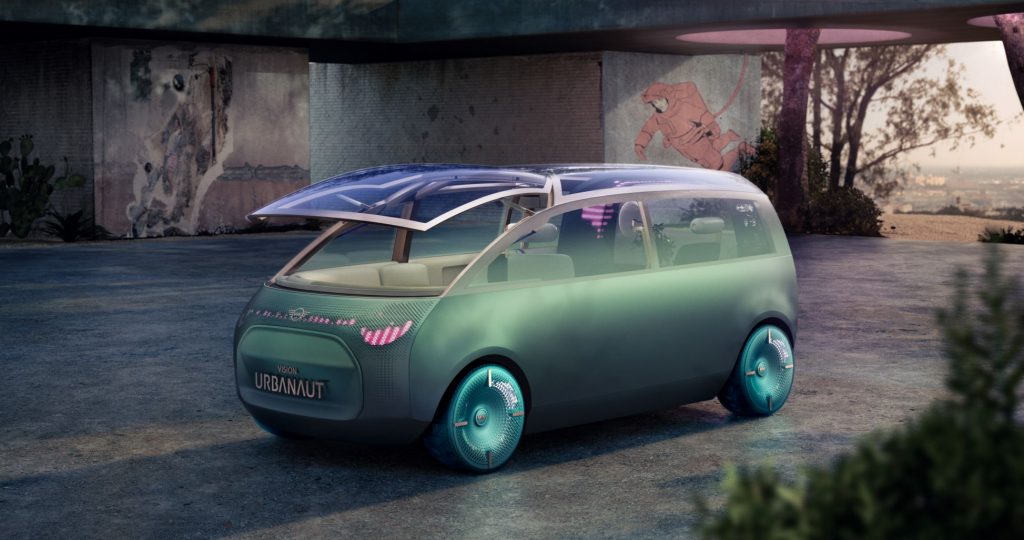
Interior – Creative Use of Space.
As an innovative space concept, the Mini Vision Urbanaut was designed from the inside out, using floor plans, pieces of furniture plus wooden scale models to provide an indication of size. Once initial blueprinting was done, augmented reality was employed to create a digital model.
Unusually tall for a Mini, but only 4.46m in length, the Mini Vision Urbanaut provides an interior space that can be used in numerous ways, offering unprecedented ease of movement inside the car.
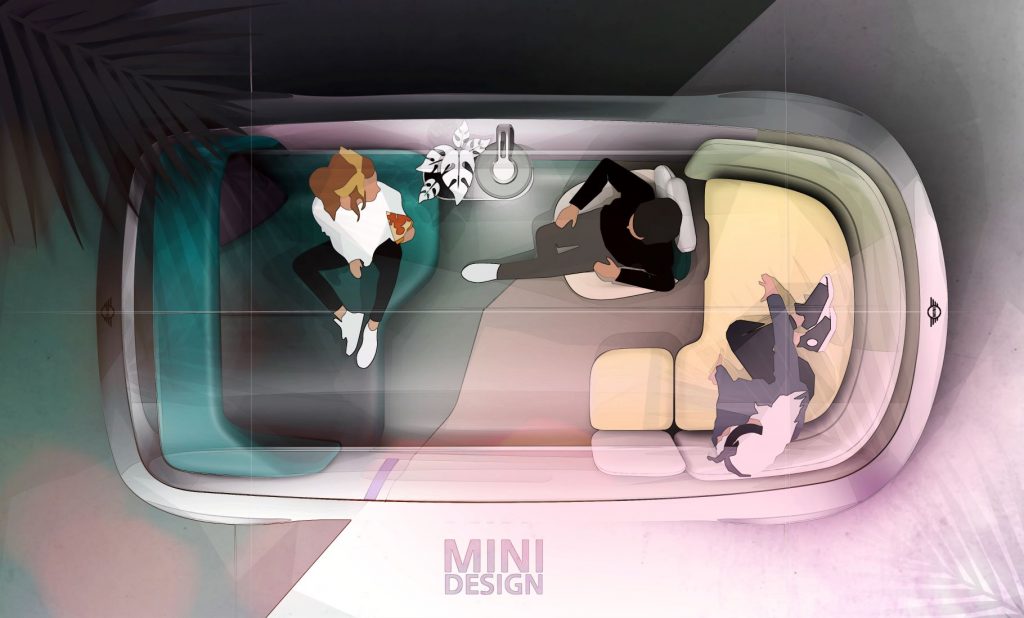
Automated electric drive to maximise interior use.
Conceived from the beginning as an electric vehicle with automated driving functions, the Mini Vision Urbanaut afforded designers a greater level of autonomy.
“In 1959, the very first Mini ushered in a small-scale revolution in vehicle construction with its transversely mounted engine,” recalls Oliver Heilmer, Head of Mini Design. “With the Mini Vision Urbanaut we have been able to rethink and increase the usable surface area inside the car even further in relation to its footprint.”
Occupants enter the innovative cabin through a large sliding door in the side of the car. The slide and swivel mechanism is ideal for urban driving conditions, where space is at a premium. There are no other doors on the driver’s side or front passenger side.
An extremely flexible four-seat layout provides the basis for the bright interior. The two front seats are designed to rotate, while the backrests for the generously sized seat surface in the rear can be folded manually and turned around.
When the car is stationary, the dashboard lowers and the driver’s area becomes a comfortable seating corner – the “day bed”. The windscreen can be opened upwards to create a kind of Street Balcony, creating an even more generous sense of space.
The cabin’s rear section provides a quieter space – the Cosy Corner. A textile covered “Loop” extends over the seat bench and features the option of LED backlighting. Between Cosy Corner and the driver’s area is the open and airy central section of the car, which offers quick access to all seating areas. On the side of the car opposite the entry door, a small integrated table with a plant adds a finishing touch to the interior fittings.
The table signifies the car’s new centre point – the place where passengers meet, face and engage with one another.
Interface design – “Analogue love, digital connection”. “Peace, love, stay cool, man.”
Intuitive, discreet user interface solutions allow conventional controls such as switches or buttons to be omitted, creating a minimalist, cosy experience while maintaining cutting-edge connectivity.
The principle of making things as simple as possible to use is highlighted by the “analogue”, tactile, haptic experiences of initiating a feature. Mini’s signature circular instrument display is now positioned in the middle of the car, and brings information to the place where people meet.
The Mini Token is the centrepiece of the Mini Vision Urbanaut’s experience worlds. It is roughly the same size as a worry stone (a what?) and activates the three preconfigured Mini moments – Chill, Wanderlust and Vibe – when placed in purpose-designed slots in the table at the centre of the car. Other Mini moments are conceivable, such as “My Mini moment”. Here, the user can configure their own preferred scenario of fragrance, ambient lighting, music, etc. and call it up directly at a later time.
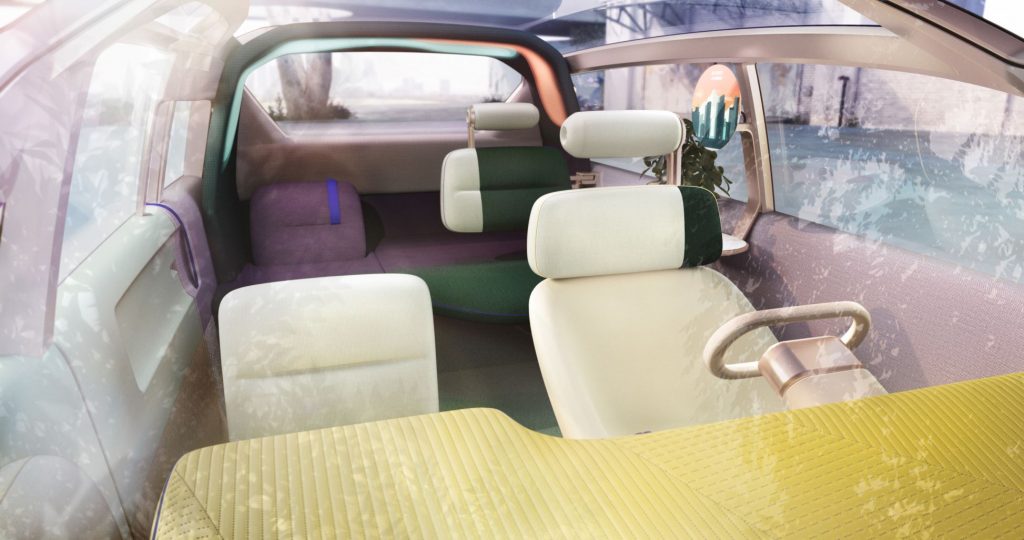
The Mini Spirit in a brand new form
The front end of the Mini Vision Urbanaut presents evolutions of two time-honoured Mini design icons – the headlights and radiator grille.
Positioned under a milled aluminium structure with slotted openings, the headlights are only visible when switched on. Thanks to their multicolour dynamic matrix design they can display different multi-coloured graphics, and can even double as a form of communication to the outside world.
The lights on the Mini Vision Urbanaut complement the front “grille” with the look distinctive to every Mini. The enclosed grille is now octagonal in shape, representing an evolution of the traditional hexagonal form.
Since the Mini Vision Urbanaut does not have a combustion engine requiring cooling air, the grille assumes a new function: it now serves as an intelligence panel for automated driving.
As with the headlights, multicolour dynamic matrix rear lights are hidden behind milled aluminium covers. On closer inspection, distinctive convex surfaces also pay homage to previous Minis and the classic Mini. One small detail – the contour of the rear windows – references the form of the front grille and underscores the car’s stylistic consistency.
The visual highlight of the Mini Vision Urbanaut when viewed from the side are the wheels, finished in the colour Ocean Wave, a turquoise blue which sparks associations with the beach and the sound of the sea (we don’t know what they’re smoking, but we’d sure like to try some!)
The abstract Union Jack profile of the wheels (we keep looking but we just can’t see it) is a nod to the car’s British heritage, while their shape mimics skateboard wheels – further highlighting the car’s non-conformist Mini vibe (or that waccy baccy). Transparent and illuminated from the inside, their appearance changes according to the selected Mini moment.
Mini moment Chill – an oasis amid the hustle and bustle of the city.
In Mini moment Chill, the Mini Vision Urbanaut becomes a private retreat, an urban oasis. While the rear seat bench invites plenty of lounging, the backlit Loop above it takes on an appearance inspired by a green forest canopy and can also be dimmed.
Ambient music and atmospheric sounds from nature are added to the mix. In the central area, the circular instrument folds down to become a table lamp, eliminating displays or switches that might remind the customer of their automotive surroundings.
From the outside, the Mini moment Chill is revealed in the abstract representation of a forest canopy around the headlights, rear lights and wheels.
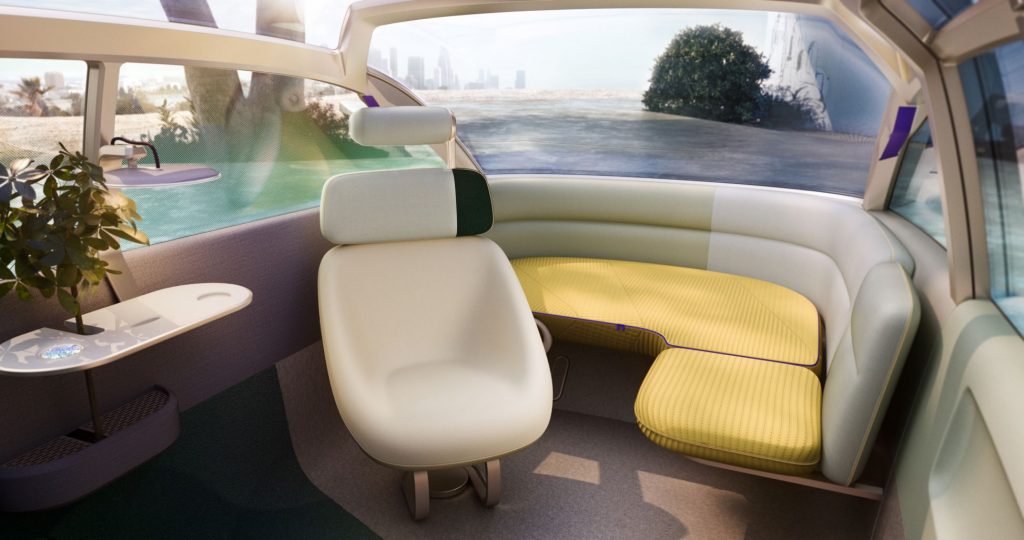
Mini moment Wanderlust – the joy of travelling together.
Wanderlust is activated when the Mini Vision Urbanaut is moving, inviting users to rediscover the romance of travel.
The user interface on the central circular instrument adapts its visuals to reflect a world of travel inspired by tourism posters of the 1950s and 60s. Alongside an animation of the route, additional journey information – such as visitor attractions and arrival time – is displayed for those on board.
The Loop above the rear seat bench visualises the feeling of movement with a simulated blur of passing scenery in a mix of orange and turquoise. When the customer wants to drive themselves, a tap of a finger on the Mini logo brings out the steering wheel and pedals.
A minimalist (the earnest tone of the release indicates to us that this can only be an unintentional pun) parallax display in the dashboard provides route instructions or hazard alerts. There are no other driving-related displays in the dashboard. When automated driving mode is activated, the steering wheel and pedals retract and the driving display disappears from the dashboard.
On the exterior of the car, the light graphics in the LED matrix surfaces at the front and rear ends signal whether automated mode has been engaged or the customer is driving themselves.
Mini moment Vibe – celebrating community, sharing moments.
In Mini moment Vibe, the Mini Vision Urbanaut opens up to people and its surroundings, and provides an experience of togetherness and interaction.
Opening the side door and folding up the windscreen creates a welcoming scene that blurs the boundaries between the outside and inside. Amid a world of magenta and black with turquoise highlights, the Mini Vision Urbanaut provides a central meeting hub; one which can be either quiet or vibing with sound.
The central circular instrument becomes a media control centre. An animation of graphic equalizers moving with the music is projected onto surfaces of the front, rear, wheels and Loop above the rear seat bench, creating a pleasant club atmosphere.
Sustainable materials and a responsible mindset.
The Mini Vision Urbanaut is characterised by the responsible use of resources. In addition to maximising space within a small footprint with the all-electric drive system, the Mini Vision Urbanaut is committed to a responsible approach to materials.
This is achieved not only by reducing the number of components in the exterior and interior design, but also by enabling dual functions such as the dashboard/daybed. Along with the use of recycled materials, this also means avoiding chrome and leather.
The dominant material in the interior is knitted textile, which combines cosiness and quality with softness and comfort. The use of cork on the steering wheel and sections of the floor adds a special touch thanks to its natural feel, and ensures an authentically pleasant interior climate.
We hate to say it, but it would appear the Mini people have been learning from the Koreans when it comes to overblown (make that “incomprehensible”) descriptions. And we wonder if the original designer of the original Mini, Sir Alec Issigonis, whose guiding principle was always form over function and who always espoused straight talking, would be impressed, or appalled.
